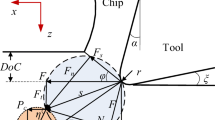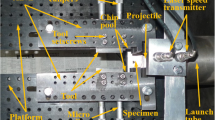Abstract
In the machining process, the workpiece is under severe plastic deformation with large strain, high strain rate, and temperature. It is necessary to know the flow stress of workpiece material in such condition to better understand the mechanism of chip formation, tool wear and damage, etc. In this study, a Split Hopkinson Pressure Bar (SHPB) with synchronically assembled heating system was employed to study the flow stress similar to the deformation condition in the machining process. A phenomenological constitutive model was proposed by the regression analysis of the experimental results. Furthermore, orthogonal metal cutting processes were carried out by the finite element method (FEM). The cutting force predicted by the FEM showed good agreement with the experimental results, which confirmed that the proposed constitutive model can give an accurate estimate of the flow stress in the machining process.
Similar content being viewed by others
References
Pawade RS, Joshi SS, Brahmankar PK (2008) Effect of machining parameters and cutting edge geometry on surface integrity of high-speed turned Inconel 718. Int J Mach Tool Manu 48:15–28
List G, Sutter G, Bi XF, Molinari A, Bouthiche A (2013) Strain, strain rate and velocity fields determination at very high cutting speed. J Mater Process Technol 213:693–699
Yan DP, Hilditch T, Kishawy HA, Littlefair G (2013) On quantifying the strain rate during chip formation when machining aerospace Alloy Ti-5553. Procedia CIRP 8:123–128
Ulutan D, Ozel T (2011) Machining induced surface integrity in titanium and nickel alloys: a review. Int J Mach Tool Manu 51:250–280
Zhang S, Li JF, Sun J, Jiang F (2010) Tool wear and cutting forces variation in high-speed end-milling Ti-6Al-4 V alloy. Int J Adv Manuf Technol 46:69–78
He N, Lee TC, Lau WS, Chan SK (2002) Assessment of deformation of a shear localized chip in high speed machining. J Mater Process Technol 129:101–104
Davim JP, Maranhao C, Jackson MJ, Cabral G, Gracio J (2008) FEM analysis in high speed machining of aluminum alloy (Al7075–0) using polycrystalline diamond (PCD) and cemented carbide (K10) cutting tools. Int J Adv Manuf Technol 39:1093–1100
Gonzalo O, Jauregi H, Uriarte LG, Lopez de Lacalle LN (2009) Predict ion of specific force coefficients from a FEM cutting model. Int J Adv Manuf Technol 43:348–356
Ambati R, Yuan H (2011) FEM mesh-dependence in cutting process simulations. Int J Adv Manuf Technol 53:313–323
Wu HB, Zhang SJ (2014) 3D FEM simulation of milling process for titanium alloy Ti6Al4V. Int J Adv Manuf Technol 71:1319–1326
Ye GG, Xue SF, Jiang MQ, Tong XH, Dai LH (2013) Modeling periodic adiabatic shear band evolution during high speed machining Ti-6Al-4 V alloy. Int J Plasticity 40:39–55
Lin YC, Chen XM (2011) A critical review of experimental results and constitutive descriptions for metals and alloys in hot working. Mater Design 32:1733–1759
Jiang F, Yan L, Rong YM (2013) Orthogonal cutting of hardened AISI D2 steel with TiAlN-coated inserts—simulations and experiments. Int J Adv Manuf Technol 64:1555–1563
Kazeminezhad M, Hosseini E (2010) Modeling of induced empirical constitutive relations on materials with FCC, BCC, and HCP crystalline structures: severe plastic deformation. Int J Adv Manuf Technol 47:1033–1039
Gao CY, Zhang LC (2013) Constitutive modelling of plasticity of fcc metals under extremely high strain rates. Int J Plasticity 32:121–133
Wang M, Yang H, Zhang C, Guo L (2013) Microstructure evolution modeling of titanium alloy large ring in hot ring rolling. Int J Adv Manuf Technol 66:1427–1437
Sima M, Ozel N (2010) Modified material constitutive models for serrated chip formation simulations and experimental validation in machining of titanium alloy Ti–6Al–4V. Int J Mach Tool Manu 50:943–960
Calamaz M, Coupard D, Girot F (2008) A new material model for 2D numerical simulation of serrated chip formation when machining titanium alloy Ti–6Al–4 V. Int J Mach Tool Manu 48:275–288
Rusinek A, Rodrıguez-Martınez JA, Arias A (2010) A thermo-viscoplastic constitutive model for FCC metals with application to OFHC copper. Int J Mech Sci 52:120–135
Liang R, Khan AS (1999) A critical review of experimental results and constitutive models for BCC and FCC metals over a wide range of strain rates and temperatures. Int J Plasticity 15:963–980
Khan AS, Suh YS, Kazmi R (2004) Quasi-static and dynamic loading responses and constitutive modeling of titanium alloys. Int J Plasticity 20:2233–2248
Lee WS, Lin CF, Chen TH, Chen HW (2011) Dynamic mechanical behavior and dislocation substructure evolution of Inconel 718 over wide temperature range. Mat Sci Een A 528:6279–6286
Hernandez C, Maranon A, Ashcroft IA, Casas-Rodriguez JP (2011) An inverse problem for the characterization of dynamic material model parameters from a single SHPB test. Procedia Engineering 10:1603–1608
Wang QZ, Li W, Xie HP (2009) Dynamic split tensile test of Flattened Brazilian Disc of rock with SHPB setup. Mech Mater 41:252–260
Li Y, Guo Y, Hu H, Wei Q (2009) A critical assessment of high-temperature dynamic mechanical testing of metals. Int J Impact Eng 36:177–184
Lindholm US (1964) Some experiments with the split Hopkinson pressure bar. J Mech Phys Solids 12:317–335
Li H, He L, Zhao G, Zhang L (2013) Constitutive relationships of hot stamping boron steel B150 0HS based on the modified Arrhenius and Johnson–Cook model. Mat Sci Een A 580:330–348
He A, Xie GL, Zhang HL, Wang XT (2013) A comparative study on Johnson–Cook, modified Johnson–Cook and Arrhenius-type constitutive models to predict the high temperature flow stress in 20CrMo alloy steel. Mater Design 52:677–685
Hou QY, Wang JT (2010) A modified Johnson–Cook constitutive model for Mg–Gd–Y alloy extended to a wide range of temperatures. Comp Mater Sci 50:147–152
Author information
Authors and Affiliations
Corresponding author
Rights and permissions
About this article
Cite this article
Yu, J., Jiang, F., Rong, Y. et al. Numerical study the flow stress in the machining process. Int J Adv Manuf Technol 74, 509–517 (2014). https://doi.org/10.1007/s00170-014-5966-5
Received:
Accepted:
Published:
Issue Date:
DOI: https://doi.org/10.1007/s00170-014-5966-5




